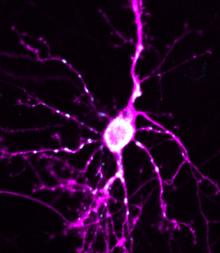
NIH-funded mouse study suggests protein may play critical role in brain changes during adolescence
The brain continues to grow and change long after we are born, but starts to settle down and mature during our teen years. According to a new mouse study published in Cell Reports, scientists have discovered the molecule that helps trigger the process of brain maturation. The study was funded by the National Institutes of Health.
“Even after birth, the brain continues to undergo tremendous change and this is a tightly regulated process,” said Timothy LaVaute, Ph.D., program director at the NIH’s National Institute of Neurological Disorders and Stroke (NINDS). “Any miscues during this time can have devastating long-term effects on the brain.”
Brain cells talk to one another at synapses, the communication points between neurons. As they talk, neurons receive information at dendritic spines, which are mushroom-like protrusions sticking out from long extensions on the cell. After birth, as neurons are establishing connections, spines fluctuate in size but eventually stabilize to assume their final shape, a complex process that involves several different proteins.
According to results from a group led by Anthony J. Koleske, Ph.D., professor at Yale University in New Haven, Connecticut, the molecule that activates this process is laminin α5, which belongs to a family of large secreted proteins that are important for providing structure to which cells can attach.
“We have found an important cue for maturation, which is critical for optimizing the number of synapses in the brain as well as their size and shape,” said Dr. Koleske. “It was thought that laminins were too large to play a role in brain synapses, but our data suggest that small pieces of laminin α5 are enough to activate this process.”
Dr. Koleske and his colleagues discovered that laminin α5 was found at synapses in the brains of young mice. Specifically, laminin α5 was produced by the neuron on the receiving end of the synapse. When the team looked into the brains of young mice that were missing laminin α5, the synapse appearance and number were completely normal. However, as the mice reached adolescence, the researchers observed a decrease in synapse number as well as a range of sizes of dendritic spines, indicating a lack of proper brain maturation and stabilization of synaptic connections.
The animals lacking laminin α5 also performed poorly on learning and memory tests, compared to mice with normal levels of the protein. Together, these findings suggest that laminin α5 is required for the brain to function correctly.
More research is necessary to identify what activates laminin α5 as well as the molecules that control the timing of the maturation process. In addition, future studies may help explain how the process is affected by various diseases.
This work was supported by the NINDS (NS08966, NS090767) and the NIH’s National Institute of Deafness and Other Communicative Disorders (DC13791, DC012441).
References:
Omar M et al. CNS Neurons Deposit Laminin α5 to Stabilize Synapses. Cell Reports. October 31, 2017.
###
The NINDS (http://www.ninds.nih.gov) is the nation’s leading funder of research on the brain and nervous system. The mission of NINDS is to seek fundamental knowledge about the brain and nervous system and to use that knowledge to reduce the burden of neurological disease.
About the National Institutes of Health (NIH): NIH, the nation's medical research agency, includes 27 Institutes and Centers and is a component of the U.S. Department of Health and Human Services. NIH is the primary federal agency conducting and supporting basic, clinical, and translational medical research, and is investigating the causes, treatments, and cures for both common and rare diseases. For more information about NIH and its programs, visit http://www.nih.gov.
